语言治疗学试题A
- 格式:docx
- 大小:17.76 KB
- 文档页数:3
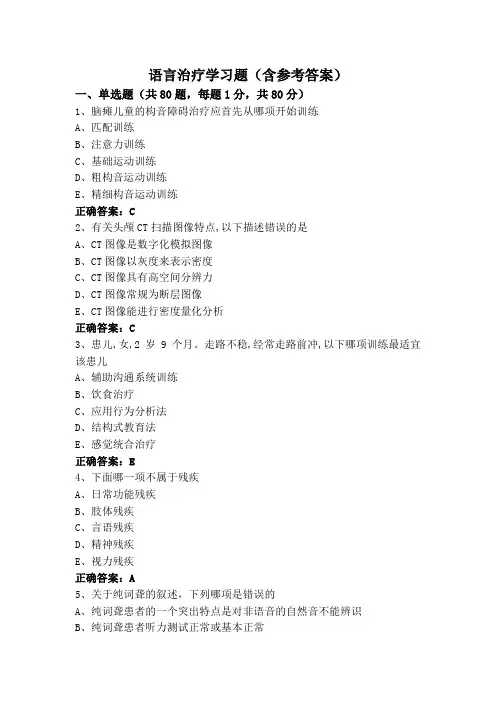
语言治疗学习题(含参考答案)一、单选题(共80题,每题1分,共80分)1、脑瘫儿童的构音障碍治疗应首先从哪项开始训练A、匹配训练B、注意力训练C、基础运动训练D、粗构音运动训练E、精细构音运动训练正确答案:C2、有关头颅CT扫描图像特点,以下描述错误的是A、CT图像是数字化模拟图像B、CT图像以灰度来表示密度C、CT图像具有高空间分辨力D、CT图像常规为断层图像E、CT图像能进行密度量化分析正确答案:C3、患儿,女,2岁9个月。
走路不稳,经常走路前冲,以下哪项训练最适宜该患儿A、辅助沟通系统训练B、饮食治疗C、应用行为分析法D、结构式教育法E、感觉统合治疗正确答案:E4、下面哪一项不属于残疾A、日常功能残疾B、肢体残疾C、言语残疾D、精神残疾E、视力残疾正确答案:A5、关于纯词聋的叙述,下列哪项是错误的A、纯词聋患者的一个突出特点是对非语音的自然音不能辨识B、纯词聋患者听力测试正常或基本正常C、单一语言方面的问题D、对口语理解严重障碍,症状持久E、病变部位可能位于左侧颞叶皮质下,或者双侧颞叶皮质正确答案:A6、患儿,男,19个月,家里人发现不会叫爸妈来院就诊,听力筛查结果为中度听力障碍。
下面哪项不适合用于训练该患儿的听觉A、辨别声源B、社会性,情绪情感等方面的培养C、分辨交通工具的声响D、噪声刺激训练E、乐音刺激训练正确答案:B7、下列关于PPA的诊断的描述,正确的是A、语言障碍是影响日常生活活动能力的主要原因B、病情可更好的由其他非退行性神经系统等疾病解释C、认知障碍可更好的由精神心理疾病解释D、发病初期视觉记忆及视感知觉障碍E、发病初期突出的行为障碍正确答案:A8、帕金森病导致的构音障碍类型是A、运动过弱型构音障碍B、弛缓型构音障碍C、混合型构音障碍D、失调型构音障碍E、痉挛型构音障碍正确答案:A9、儿童语言发育迟缓治疗,一个疗程时间一般为A、5个月B、4个月C、3个月D、2个月E、6个月正确答案:C10、促进实用交流能力的训练时,常常应用PACE评分法,当语言治疗师通过的多次询问,或借助手势、书写等代偿手段将信息传递成功,应评为几分A、5分B、4分C、3分D、2分E、1分正确答案:C11、Broca 区又称A、阅读中枢B、运动性语言中枢C、书写中枢D、感觉性语言中枢E、视觉中枢正确答案:B12、诊断口咽障碍金标准A、食管测压B、进食试验C、鼻内镜检查D、吞水试验E、影像学荧光检查正确答案:E13、额叶失读的病理损害部位是A、左侧半球角回B、左侧顶颞叶交界区C、左侧额叶后部D、胼胝体头部E、左侧枕叶距状区正确答案:C14、根据符号形式与指示内容关系(S-S)法共分为几个阶段A、四个阶段B、六个阶段C、三个阶段D、两个阶段E、五个阶段正确答案:E15、在语言交流中语言理解是从句子的A、深层结构到表层结构的过程B、表层结构到深层结构的过程C、表层结构到表层结构的过程D、深层结构到深层结构的过程E、深层结构到中层结构的过程正确答案:B16、某患者语言表达采用电报式语句,检查中把“小猫被兔子赶走了”组合成“小猫兔子赶走”或“小猫了兔子被赶走”等,对这样需全面分析句法结构方能正确完成的句子,患者存在严重障碍,为A、Broca 失语B、传导性失语C、Wernicke 失语D、失语法性失语E、失读症正确答案:D17、阿尔茨海默病又被称为A、Pick病B、谵安C、老年性痴呆D、假性痴呆E、血管性痴呆正确答案:C18、被称为后天文盲的失写是A、单纯性失写症B、流畅性失写C、非流畅性失写D、Gerstmann综合征性失写E、失读伴失写正确答案:E19、一个7岁患儿,言语过程中有较多的鼻音,因语言清晰度低而难以与人交流,而且说话时音调单一、音量单一。
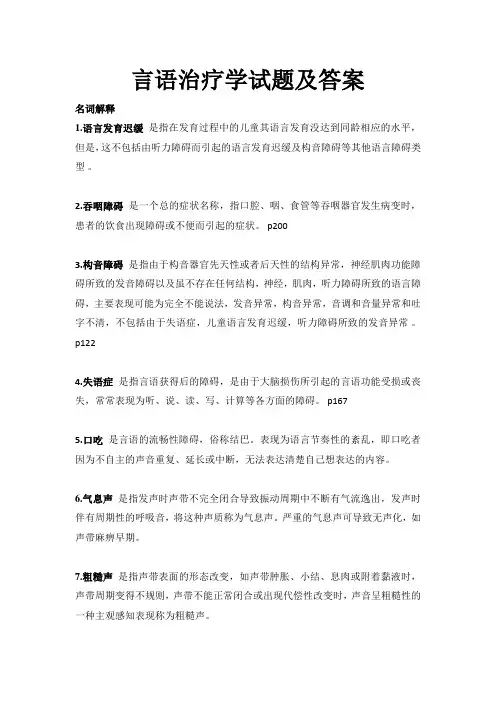
言语治疗学试题及答案名词解释1.语言发育迟缓是指在发育过程中的儿童其语言发育没达到同龄相应的水平,但是,这不包括由听力障碍而引起的语言发育迟缓及构音障碍等其他语言障碍类型。
2.吞咽障碍是一个总的症状名称,指口腔、咽、食管等吞咽器官发生病变时,患者的饮食出现障碍或不便而引起的症状。
p2003.构音障碍是指由于构音器官先天性或者后天性的结构异常,神经肌肉功能障碍所致的发音障碍以及虽不存在任何结构,神经,肌肉,听力障碍所致的语言障碍,主要表现可能为完全不能说法,发音异常,构音异常,音调和音量异常和吐字不清,不包括由于失语症,儿童语言发育迟缓,听力障碍所致的发音异常。
p1224.失语症是指言语获得后的障碍,是由于大脑损伤所引起的言语功能受损或丧失,常常表现为听、说、读、写、计算等各方面的障碍。
p1675.口吃是言语的流畅性障碍,俗称结巴。
表现为语言节奏性的紊乱,即口吃者因为不自主的声音重复、延长或中断,无法表达清楚自己想表达的内容。
6.气息声是指发声时声带不完全闭合导致振动周期中不断有气流逸出,发声时伴有周期性的呼吸音,将这种声质称为气息声。
严重的气息声可导致无声化,如声带麻痹早期。
7.粗糙声是指声带表面的形态改变,如声带肿胀、小结、息肉或附着黏液时,声带周期变得不规则,声带不能正常闭合或出现代偿性改变时,声音呈粗糙性的一种主观感知表现称为粗糙声。
8.痴呆是一种获得性、持续性智能损害综合症,即在无意识障碍的情况下,在认知、记忆、语言、视空间技能、情感或人格等5项精神活动领域中,有认知和记忆功能障碍等至少三项功能缺损,且影响其社会生活活动功能者。
p2379.口颜面失用是指在非语言状态下,虽然与言语产生活动有关的肌肉自发活动仍然存在,但是舌、唇、喉、咽、颊肌执行自主运动困难。
临床上言语失用不伴有口失用,但口失用常伴有言语失用。
p24010.言语失用是不能执行自主运动进行发音和言语活动。
而且这种异常是在缺乏或不能用言语肌肉的麻痹、减弱或不协调来解释的一种运动性语言障碍,或者说是一种运动程序障碍p24111.孤独症又称自闭症,是一种起病于幼年时期的广泛性神经系统发育障碍性疾病。
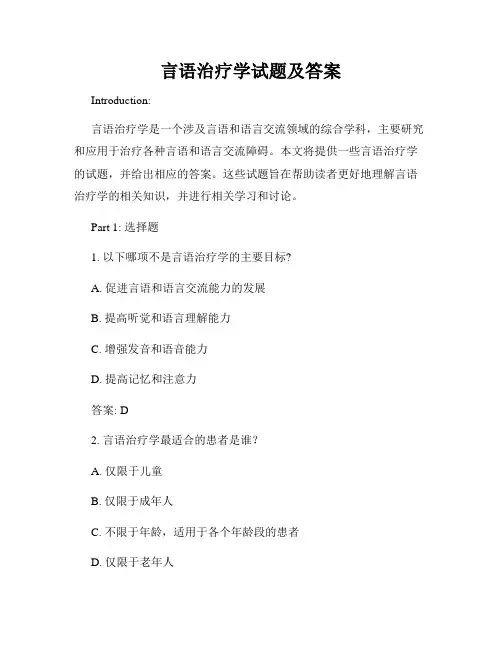
言语治疗学试题及答案Introduction:言语治疗学是一个涉及言语和语言交流领域的综合学科,主要研究和应用于治疗各种言语和语言交流障碍。
本文将提供一些言语治疗学的试题,并给出相应的答案。
这些试题旨在帮助读者更好地理解言语治疗学的相关知识,并进行相关学习和讨论。
Part 1: 选择题1. 以下哪项不是言语治疗学的主要目标?A. 促进言语和语言交流能力的发展B. 提高听觉和语言理解能力C. 增强发音和语音能力D. 提高记忆和注意力答案: D2. 言语治疗学最适合的患者是谁?A. 仅限于儿童B. 仅限于成年人C. 不限于年龄,适用于各个年龄段的患者D. 仅限于老年人答案: C3. 以下哪个不是言语治疗学的常见治疗领域?A. 语言障碍B. 学习困难C. 感知障碍D. 发音障碍答案: CPart 2: 解答题1. 请简要解释言语治疗学的基本原则。
言语治疗学的基本原则包括以下几个方面:- 个体化:治疗师需要根据每个患者的具体情况,制定个体化的治疗计划,以满足其特定的治疗需求。
- 适应性:治疗师应根据患者的年龄、性别、文化背景等因素,调整治疗方法和语言材料,以提高治疗效果。
- 综合性:言语治疗学涉及多个领域,包括语音、语言、听觉、认知等,治疗师需要综合运用不同的技术和方法,以全面促进患者的言语和语言交流能力。
- 持续性:治疗是一个长期的过程,患者需要定期接受治疗,并配合家庭和学校的支持,以达到最佳的治疗效果。
2. 请列举言语治疗学的常见评估工具。
言语治疗学的常见评估工具包括以下几个:- 言语和语言评估表:用于评估患者的发音、语音、理解和表达能力。
- 语言样本分析:通过记录患者的语言样本并进行分析,评估其语言发展水平和语法能力。
- 听觉评估:通过听力测试和听觉空间定位等评估方法,评估患者的听觉功能和听觉处理能力。
- 认知评估:通过认知测验和认知行为观察等评估方法,评估患者的认知功能和注意力水平。
Conclusion:本文提供了一些关于言语治疗学的试题,并给出了相应的答案。
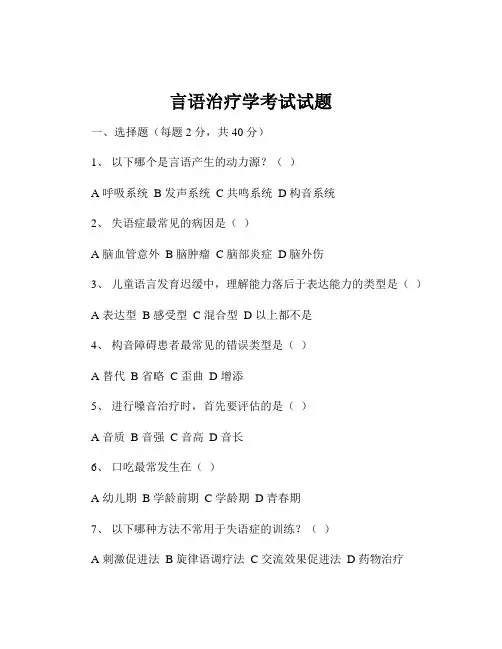
言语治疗学考试试题一、选择题(每题 2 分,共 40 分)1、以下哪个是言语产生的动力源?()A 呼吸系统B 发声系统C 共鸣系统D 构音系统2、失语症最常见的病因是()A 脑血管意外B 脑肿瘤C 脑部炎症D 脑外伤3、儿童语言发育迟缓中,理解能力落后于表达能力的类型是()A 表达型B 感受型C 混合型D 以上都不是4、构音障碍患者最常见的错误类型是()A 替代B 省略C 歪曲D 增添5、进行嗓音治疗时,首先要评估的是()A 音质B 音强C 音高D 音长6、口吃最常发生在()A 幼儿期B 学龄前期C 学龄期D 青春期7、以下哪种方法不常用于失语症的训练?()A 刺激促进法B 旋律语调疗法C 交流效果促进法D 药物治疗8、对于自闭症儿童的语言训练,重点在于()A 语法规则的学习B 社交语言的运用C 词汇量的增加D 发音的准确性9、吞咽障碍患者容易发生误吸的时期是()A 口腔准备期B 口腔推送期C 咽期D 食管期10、以下哪种评估工具常用于儿童语言发育迟缓的评估?()A 汉语失语症成套测验B 构音障碍评定法C 语言发育迟缓检查法D 嗓音障碍评估11、语音治疗中,针对舌尖音错误的训练方法是()A 舌尖抵住上齿龈B 舌尖抵住下齿龈C 舌尖抵住硬腭前部D 舌尖抵住软腭12、以下哪项不是口吃的特点?()A 重复B 拖音C 语速过快D 插入13、唇腭裂患者常见的语音问题是()A 鼻音过重B 元音错误C 声调错误D 语速缓慢14、成人失语症患者训练的最佳时期是()A 发病后 1 3 个月B 发病后 3 6 个月C 发病后 6 12 个月D 发病1 年后15、对于发声障碍患者,进行呼吸训练时,哪种呼吸方式最有效?()A 胸式呼吸B 腹式呼吸C 胸腹联合式呼吸D 以上都不是16、以下哪种不是儿童语言发展的关键期?()A 0 1 岁B 1 3 岁C 3 5 岁D 5 7 岁17、吞咽障碍患者进行摄食训练时,食物的性状应从()开始。
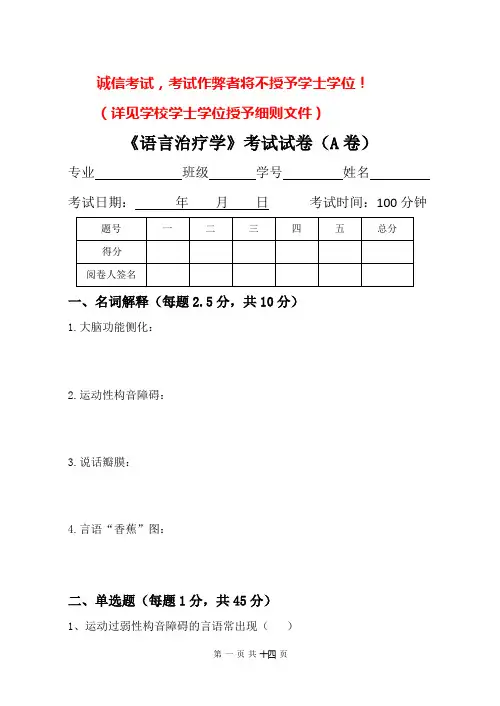
诚信考试,考试作弊者将不授予学士学位!(详见学校学士学位授予细则文件)《语言治疗学》考试试卷(A卷)专业班级学号姓名考试日期:年月日考试时间:100分钟一、名词解释(每题2.5分,共10分)1.大脑功能侧化:2.运动性构音障碍:3.说话瓣膜:4.言语“香蕉”图:二、单选题(每题1分,共45分)1、运动过弱性构音障碍的言语常出现()A.粗糙音B.音量大C.鼻音D.单一音量、单一音调2、费力音常见于()A.弛缓型构音障碍B.痉挛型构音障碍C.混合型构音障碍D.运动过弱型构音障碍3、气息音常见于()A.弛缓型构音障碍B.痉挛型构音障碍C.运动过强型构音障碍D.运动过弱型构音障碍4、经评估发现某腭裂患者存在自腭垂至切牙孔完全裂开体征,患者目前属于()A.不完全腭裂B.软腭裂C.单侧完全性腭裂D.双侧完全性腭裂5、下列哪项是目前评价腭咽闭合功能最重要与最常用的工具()A.鼻咽纤维内窥镜B.鼻息镜C.语图仪D.鼻音计6、腭裂语音训练一般从术后()开始,此时术后肿胀已基本消退。
A.1~2个月B.2~3个月C.3~4个月D.4~5个月7、对于腭裂临床表现描述正确的是()A.口面部发育基本正常B.牙齿序列基本正常C.鼻部发育基本正常D.共鸣功能不正常8、语言发育迟缓患儿的临床表现不包括下列哪一项()A.过了说话的年龄仍不会说话B.开始说话后,比正常的孩子发展慢或出现停滞C.语言应用,词汇和语法应用均低D.患儿的智力低下,注意力集中,愿意与他人交流9、在导致儿童语言发育迟缓的众多因素中,最常见的因素是()A.听觉障碍B.儿童孤独症C.智力发育迟缓D.癫痫10、受语言学习限定的特异性儿童语言发育迟缓是指()A.发育性感觉性失语B.语言环境的脱离和不良C.智力发育迟缓D.儿童孤独症11、S-S检查法适于年龄段()A.2.5~18岁B.3岁~8岁11个月C.4~4.5岁D.1.5~6.5岁12、符号形式-指示内容的关系评估的阶段3-2是语言发育在()A.1.5岁以上B.2.5岁以上C.2.0岁以上D.1岁以上13、以下哪项检查不适合对语言发育迟缓儿童的评估()A.皮博迪图片词汇检查(PPVT)B.伊力诺斯心理语言能力测试(ITPA)C.听力检查D.韦氏成人智力量表14、在对发育迟缓患儿进行S-S评估时,不可直接用图片检查的阶段是()A.2-1阶段B.3-2阶段C.4-1阶段D.5-1阶段15、语言发育迟缓的A群的条件是符号与指示内容关系的检查在哪个阶段()A.3-1以上B.3-1以下C.4-1以上D.4-1以下16、语言发育迟缓的B群条件除了阶段4-1以上,年龄要()A.满6岁以上B.满3岁以上C.满5岁以上D.满4岁以上17、如果患者被诊断为I群的A群b,那么患儿语言方面的情况为以下哪种()A.交流态度不好,言语符号已经掌握,动作性课题>言语符号B.交流态度不好,言语符号未掌握,动作性课题=言语符号C.交流态度好,言语符号未掌握,动作性课题=言语符号D.交流态度好,言语符号未掌握,动作性课题>言语符号18、儿童语言发育迟缓训练中,不属于精神鼓励的是()A.口头称赞B.贴星星C.玩玩具D.大人愉悦的表情19、对于交流障碍的语迟儿童,应首先从哪项开始训练()A.交流训练B.听力训练C.听理解训练D.命名训练20、对于注意力差的语迟儿童,应首先从哪项开始训练()A.注意力训练B.命名训练C.言语符号训练D.模仿训练21、下列哪项不属于口吃A群言语症状()A.音.音节的重复B.异常呼吸C.在不自然的位置出现重音或爆发式发音D.元音、辅音延长22、下列哪项不属于口吃患者努力性表现行为()A.解除反应B.助跑现象C.情绪性反应D.回避23、一般来说,儿童在下列哪种情况时常会发生说话欠流利()A.必须给对方一个好印象B.表达内容很重要C.发觉自己口吃D.在严厉的束缚下说话时24、以下惊恐发作的诊断标准,那一项是错误的()A.或首次发作后继发害怕,再发作的焦虑持续1个月B.以惊恐发作症状为主要临床相C.每次发作短暂(一般短于2小时),再发作时一般不影响日常活动D.一个月内至少发作3次25、下面那种缄默症为器质性缄默症()A.癔症性缄默症B.选择性缄默症C.无动性缄默症D.妄想性缄默症26、患者通过视觉和嗅觉感知食物,用餐具.杯子或手指将食物送至口中属于吞咽运动的()A.口腔期B.口腔前期C.口腔准备期D.食管期27、假性延髓麻痹为()A.下运动神经元损害B.单侧上运动神经元C.脊髓病变D.双侧上运动神经元损害28、下列哪项检查是诊断吞咽障碍的“金标准”()A.饮水试验B.测压检查C.VFSS检查D.超声检查29、用来描述人听力水平的名词是()A.频率B.分贝C.听阈D.响度30、下列关于听力计检查法的叙述错误的是()A.适合3岁以下儿童的听力检查B.是目前医院中最常见的听力检查方法C.主要用来判断听力障碍的类型D.可以估计病变部位及评价助听器的验配31、对于Wernicke失语说法正确的是()A.表现为杂乱语B.出现电报式言语C.表现听理解障碍轻微D.颞中回损伤常见32、复述相对保留的是()A.传导性失语B.命名性失语C.纯词聋D.经皮质性失语33、男性,58岁,右利手,以“右侧肢体活动不灵、言语不利半年”入院。
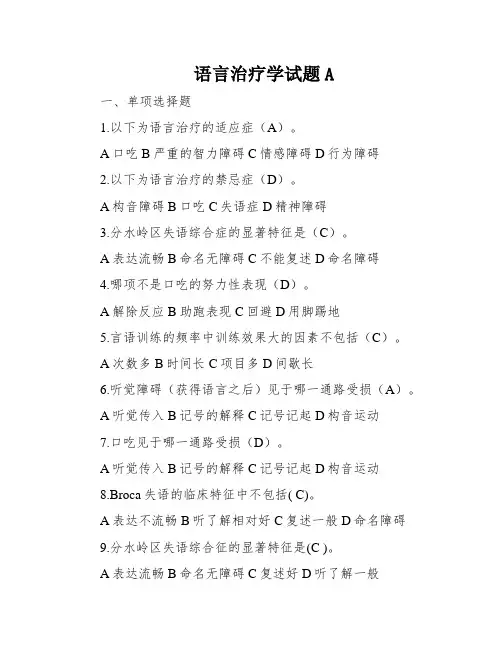
语言治疗学试题A一、单项选择题1.以下为语言治疗的适应症(A)。
A口吃B严重的智力障碍C情感障碍D行为障碍2.以下为语言治疗的禁忌症(D)。
A构音障碍B口吃C失语症D精神障碍3.分水岭区失语综合症的显著特征是(C)。
A表达流畅B命名无障碍C不能复述D命名障碍4.哪项不是口吃的努力性表现(D)。
A解除反应B助跑表现C回避D用脚踢地5.言语训练的频率中训练效果大的因素不包括(C)。
A次数多B时间长C项目多D间歇长6.听觉障碍(获得语言之后)见于哪一通路受损(A)。
A听觉传入B记号的解释C记号记起D构音运动7.口吃见于哪一通路受损(D)。
A听觉传入B记号的解释C记号记起D构音运动8.Broca失语的临床特征中不包括( C)。
A表达不流畅B听了解相对好C复述一般D命名障碍9.分水岭区失语综合征的显著特征是(C )。
A表达流畅B命名无障碍C复述好D听了解一般10.错误构音呈固定状况多见于(B )构音障碍。
A运动性B功能性C器质性D痉挛性11.聋儿训练的原则中没有哪项(D )。
A尽早查明听力B尽早配助听器C尽早进行科学的听力言语训练D尽早手术12.悄悄行驶的小汽车发出( C)分贝的声音。
A 2 0-30B 30-40C 40-50D 50-6013.不属于语言训练适应症的是(D)A、失语症B、语言发育迟缓C、发声障碍D、行为障碍E、构音障碍14.在“言语链”中,属于言语学水平的是(A)A、大脑语言中枢B、构音器官C、耳朵D、声音的大小15.决定失语症预后的主要因素是(A)A、原发疾病和失语类型B、年龄C、智力水平D、性格E、性别16.影响言语交流的心理因素不包括(A)A、交流者的智商B、交流循环体系C、交流脚色关系D、交流环境E、交流者的欲望17.汉语标准失语症检查采纳级评分标准(D)A 3B 4C 5D 618.现在一般把运动性构音障碍分为(C)19.影响言语交流的认知因素不包括(D)。
A接受能力B记忆和研究能力C思维能力D空间知觉能力E意识与注意能力20.以下为语言治疗的禁忌症(B)A构音障碍B口吃C失语症D精神障碍二、填空题1.言语治疗最初的训练的时间限定在内。
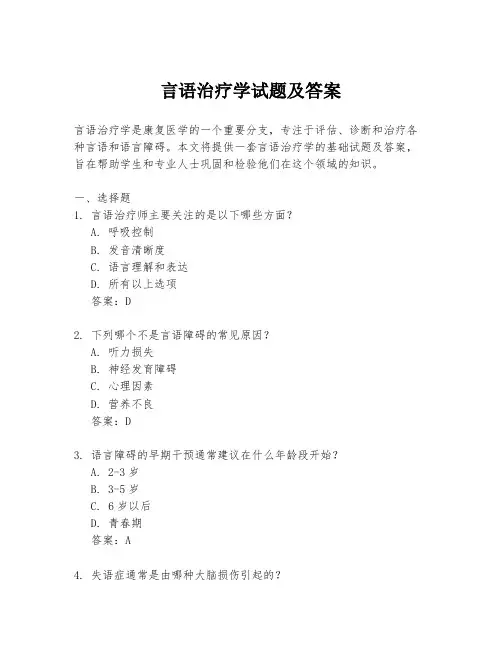
言语治疗学试题及答案言语治疗学是康复医学的一个重要分支,专注于评估、诊断和治疗各种言语和语言障碍。
本文将提供一套言语治疗学的基础试题及答案,旨在帮助学生和专业人士巩固和检验他们在这个领域的知识。
一、选择题1. 言语治疗师主要关注的是以下哪些方面?A. 呼吸控制B. 发音清晰度C. 语言理解和表达D. 所有以上选项答案:D2. 下列哪个不是言语障碍的常见原因?A. 听力损失B. 神经发育障碍C. 心理因素D. 营养不良答案:D3. 语言障碍的早期干预通常建议在什么年龄段开始?A. 2-3岁B. 3-5岁C. 6岁以后D. 青春期答案:A4. 失语症通常是由哪种大脑损伤引起的?A. 外伤性脑损伤B. 中风C. 神经退行性疾病D. 所有以上选项答案:D5. 以下哪种方法不是言语治疗的常用技术?A. 镜像疗法B. 音乐疗法C. 认知行为疗法D. 药物治疗答案:D二、填空题1. 言语治疗的目标是提高个体的________和________,以便他们能够有效地进行日常沟通。
答案:沟通能力、生活质量2. 在评估儿童的语言发展时,治疗师会使用标准化的________来确定语言技能的水平。
答案:测试工具3. 流畅言语障碍,如口吃,通常需要通过________和练习来改善。
答案:行为疗法4. 对于患有吞咽困难的个体,言语治疗师可能会推荐使用特殊的________来帮助安全进食。
答案:饮食调整5. 语音障碍可能涉及到音素的________、替换或省略。
答案:扭曲三、简答题1. 描述言语治疗师在评估过程中通常会采取哪些步骤?答案:言语治疗师在评估过程中通常会首先进行详细的病史收集,包括个体的医疗史、发展史和沟通能力。
接着,治疗师会进行一系列的标准化测试,以评估个体的语言理解、表达、发音和流畅性。
此外,治疗师可能还会观察个体在自然环境中的沟通情况,并与家庭成员或教师进行访谈,以了解个体在日常生活中的沟通需求和挑战。
2. 举例说明言语治疗如何帮助患有特定语言障碍的儿童。
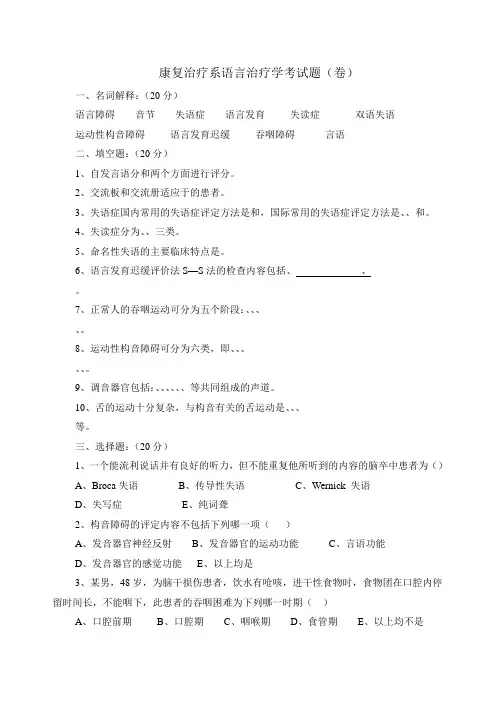
康复治疗系语言治疗学考试题(卷)一、名词解释:(20分)语言障碍音节失语症语言发育失读症双语失语运动性构音障碍语言发育迟缓吞咽障碍言语二、填空题:(20分)1、自发言语分和两个方面进行评分。
2、交流板和交流册适应于的患者。
3、失语症国内常用的失语症评定方法是和,国际常用的失语症评定方法是、、和。
4、失读症分为、、三类。
5、命名性失语的主要临床特点是。
6、语言发育迟缓评价法S—S法的检查内容包括、、。
7、正常人的吞咽运动可分为五个阶段:、、、、。
8、运动性构音障碍可分为六类,即、、、、、。
9、调音器官包括:、、、、、、等共同组成的声道。
10、舌的运动十分复杂,与构音有关的舌运动是、、、等。
三、选择题:(20分)1、一个能流利说话并有良好的听力,但不能重复他所听到的内容的脑卒中患者为()A、Broca失语B、传导性失语C、Wernick 失语D、失写症E、纯词聋2、构音障碍的评定内容不包括下列哪一项()A、发音器官神经反射B、发音器官的运动功能C、言语功能D、发音器官的感觉功能E、以上均是3、某男,48岁,为脑干损伤患者,饮水有呛咳,进干性食物时,食物团在口腔内停留时间长,不能咽下,此患者的吞咽困难为下列哪一时期()A、口腔前期B、口腔期C、咽喉期D、食管期E、以上均不是4、失语症恢复的高峰期是什么时间()A、发病后1—2月B、发病后2—4月C、发病后3—6月D、发病后6个月—1年E、发病后1年—2年5、Broca失语症的特点是()A、言语不流利、理解好、复述差B、言语流利、理解好、复述差C、言语不流利、理解差、复述好D、言语流利、理解好、复述差E、言语含糊6、病灶部位在优势半球颞叶峡部、岛叶皮质下的弓状束和联络纤维,属于()A、传导性失语B、命名性失语C、经皮质运动性失语D、完全性失语E、运动性失语7、语言发育迟缓患儿的临床表现不包括下列哪一项()A、过了说话的年龄仍不会说话B、开始说话后,比正常的孩子发展慢或出现停滞C、患儿的智力低下,注意力集中,愿意与他人交流D、交流技能低E、语言应用,词汇和语法应用均低8、正常成年人最大吸气后持续发音的时间是()A、成年男性20秒,成年女性30秒B、成年男性30秒,成年女性20秒C、成年男性10秒,成年女性20秒D、成年男性20秒,成年女性10秒E、以上均不对9、运动性失调型构音障碍涉及()A、小脑或脑干内传导束病变B、下运动神经元损伤C、锥体外系病变D、上运动神经元损伤E、脊髓病变10、发音训练不包括下列哪一项()A、发音器官的启动B、持续发音训练C、音量控制D、鼻音控制训练E、听理解训练四、简述题1、简述BDAE失语症严重程度分级标准。
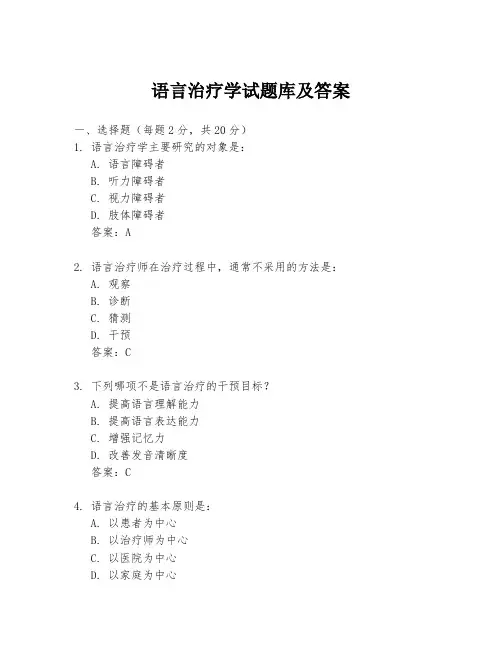
语言治疗学试题库及答案一、选择题(每题2分,共20分)1. 语言治疗学主要研究的对象是:A. 语言障碍者B. 听力障碍者C. 视力障碍者D. 肢体障碍者答案:A2. 语言治疗师在治疗过程中,通常不采用的方法是:A. 观察B. 诊断C. 猜测D. 干预答案:C3. 下列哪项不是语言治疗的干预目标?A. 提高语言理解能力B. 提高语言表达能力C. 增强记忆力D. 改善发音清晰度答案:C4. 语言治疗的基本原则是:A. 以患者为中心B. 以治疗师为中心C. 以医院为中心D. 以家庭为中心答案:A5. 语言治疗中,哪种类型的障碍不属于语言障碍?A. 表达性语言障碍B. 接受性语言障碍C. 听力障碍D. 混合性语言障碍答案:C6. 语言治疗师在评估过程中,不需要考虑的因素是:A. 患者的年龄B. 患者的文化背景C. 患者的情绪状态D. 治疗师的个人偏好答案:D7. 语言治疗中,哪项技术不常用于治疗语言障碍?A. 刺激强化B. 行为疗法C. 药物治疗D. 语言练习答案:C8. 语言治疗师在制定治疗计划时,不需要考虑的因素是:A. 患者的个人需求B. 患者的家庭环境C. 患者的经济状况D. 患者的职业需求答案:C9. 下列哪项不是语言治疗的评估工具?A. 语言评估量表B. 听力测试仪C. 视力测试仪D. 语言发展里程碑答案:C10. 语言治疗的最终目标是:A. 治愈语言障碍B. 提高语言能力C. 改善生活质量D. 增加治疗师收入答案:C二、填空题(每题2分,共20分)1. 语言治疗学是一门研究______和______的学科。
答案:语言障碍;治疗方法2. 语言治疗师在治疗过程中,需要对患者进行______和______。
答案:评估;干预3. 语言治疗的干预目标包括提高______和______。
答案:语言理解能力;语言表达能力4. 语言治疗的基本原则是以______为中心。
答案:患者5. 语言治疗中,不属于语言障碍的是______障碍。
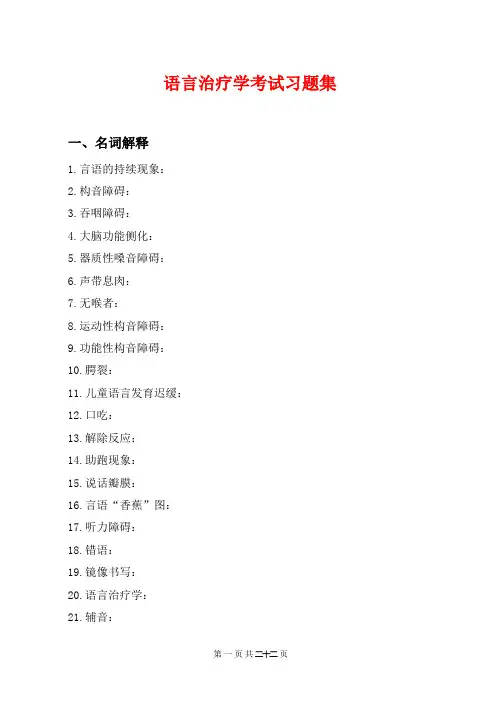
语言治疗学考试习题集一、名词解释1.言语的持续现象:2.构音障碍:3.吞咽障碍:4.大脑功能侧化:5.器质性嗓音障碍:6.声带息肉:7.无喉者:8.运动性构音障碍:9.功能性构音障碍:10.腭裂:11.儿童语言发育迟缓:12.口吃:13.解除反应:14.助跑现象:15.说话瓣膜:16.言语“香蕉”图:17.听力障碍:18.错语:19.镜像书写:20.语言治疗学:21.辅音:二、单选题1、刘某,女性,64岁,脑卒中后原右利手瘫痪,现需利手转换,用左手书写,最适合患者的书写训练是()A.随意书写B.看图写故事C.默写D.临摹和抄写2、运动过弱性构音障碍的言语常出现()A.粗糙音B.音量大C.鼻音D.单一音量、单一音调3、费力音常见于()A.弛缓型构音障碍B.痉挛型构音障碍C.混合型构音障碍D.运动过弱型构音障碍4、气息音常见于()A.弛缓型构音障碍B.痉挛型构音障碍C.运动过强型构音障碍D.运动过弱型构音障碍5、经评估发现某腭裂患者存在自腭垂至切牙孔完全裂开体征,患者目前属于()A.不完全腭裂B.软腭裂C.单侧完全性腭裂D.双侧完全性腭裂6、根据腭裂程度分类,不完全性腭裂患者其属于()A.Ⅰ度B.浅Ⅱ度C.深Ⅱ度D.Ⅲ度7、腭裂共鸣异常会出现()A.侧化构音B.咽喉摩擦音C.送气音化D.鼻漏气8、下列哪项是目前评价腭咽闭合功能最重要与最常用的工具()A.鼻咽纤维内窥镜B.鼻息镜C.语图仪D.鼻音计9、腭裂语音训练一般从术后()开始,此时术后肿胀已基本消退。
A.1~2个月B.2~3个月C.3~4个月D.4~5个月10、对于腭裂临床表现描述正确的是()A.口面部发育基本正常B.牙齿序列基本正常C.鼻部发育基本正常D.共鸣功能不正常11、语言发育迟缓患儿的临床表现不包括下列哪一项()A.过了说话的年龄仍不会说话B.开始说话后,比正常的孩子发展慢或出现停滞C.语言应用,词汇和语法应用均低D.患儿的智力低下,注意力集中,愿意与他人交流12、在导致儿童语言发育迟缓的众多因素中,最常见的因素是()A.听觉障碍B.儿童孤独症C.智力发育迟缓D.癫痫13、受语言学习限定的特异性儿童语言发育迟缓是指()A.发育性感觉性失语B.语言环境的脱离和不良C.智力发育迟缓D.儿童孤独症14、S-S检查法适于年龄段()A.2.5~18岁B.3岁~8岁11个月C.4~4.5岁D.1.5~6.5岁15、符号形式-指示内容的关系评估的阶段3-2是语言发育在()A.1.5岁以上B.2.5岁以上C.2.0岁以上D.1岁以上16、以下哪项检查不适合对语言发育迟缓儿童的评估()A.皮博迪图片词汇检查(PPVT)B.伊力诺斯心理语言能力测试(ITPA)C.听力检查D.韦氏成人智力量表17、在对发育迟缓患儿进行S-S评估时,不可直接用图片检查的阶段是()A.2-1阶段B.3-2阶段C.4-1阶段D.5-1阶段18、语言发育迟缓的A群的条件是符号与指示内容关系的检查在哪个阶段()A.3-1以上B.3-1以下C.4-1以上D.4-1以下19、语言发育迟缓的B群条件除了阶段4-1以上,年龄要()A.满6岁以上B.满3岁以上C.满5岁以上D.满4岁以上20、如果患者被诊断为I群的A群b,那么患儿语言方面的情况为以下哪种()A.交流态度不好,言语符号已经掌握,动作性课题>言语符号B.交流态度不好,言语符号未掌握,动作性课题=言语符号C.交流态度好,言语符号未掌握,动作性课题=言语符号D.交流态度好,言语符号未掌握,动作性课题>言语符号21、儿童语言发育迟缓训练中,不属于精神鼓励的是()A.口头称赞B.贴星星C.玩玩具D.大人愉悦的表情22、对于交流障碍的语迟儿童,应首先从哪项开始训练()A.交流训练B.听力训练C.听理解训练D.命名训练23、对于注意力差的语迟儿童,应首先从哪项开始训练()A.注意力训练B.命名训练C.言语符号训练D.模仿训练24、下列哪项不属于口吃A群言语症状()A.音.音节的重复B.异常呼吸C.在不自然的位置出现重音或爆发式发音D.元音、辅音延长25、下列哪项不属于口吃患者努力性表现行为()A.解除反应B.助跑现象C.情绪性反应D.回避26、一般来说,儿童在下列哪种情况时常会发生说话欠流利()A.必须给对方一个好印象B.表达内容很重要C.发觉自己口吃D.在严厉的束缚下说话时27、以下惊恐发作的诊断标准,那一项是错误的()A.或首次发作后继发害怕,再发作的焦虑持续1个月B.以惊恐发作症状为主要临床相C.每次发作短暂(一般短于2小时),再发作时一般不影响日常活动D.一个月内至少发作3次28、下面那种缄默症为器质性缄默症()A.癔症性缄默症B.选择性缄默症C.无动性缄默症D.妄想性缄默症29、下列属于功能性缄默症的是()A.无动性缄默症B.球麻痹性缄默症C.小脑性缄默症D.紧张性缄默症30、患者通过视觉和嗅觉感知食物,用餐具.杯子或手指将食物送至口中属于吞咽运动的()A.口腔期B.口腔前期C.口腔准备期D.食管期31、假性延髓麻痹为()A.下运动神经元损害B.单侧上运动神经元C.脊髓病变D.双侧上运动神经元损害32、下列哪项检查是诊断吞咽障碍的“金标准”()A.饮水试验B.测压检查C.VFSS检查D.超声检查33、神经性吞咽障碍的疾病不包括()A.中风B.脑外伤C.舌癌术后D.帕金森病34、吞咽的辅助手法包括()A.声门上吞咽法B.用力吞咽法C.门德尔松吞咽技术D.以上都是35、用来描述人听力水平的名词是()A.频率B.分贝C.听阈D.响度36、下列关于听力计检查法的叙述错误的是()A.适合3岁以下儿童的听力检查B.是目前医院中最常见的听力检查方法C.主要用来判断听力障碍的类型D.可以估计病变部位及评价助听器的验配37、对于Wernicke失语说法正确的是()A.表现为杂乱语B.出现电报式言语C.表现听理解障碍轻微D.颞中回损伤常见38、复述相对保留的是()A.传导性失语B.命名性失语C.纯词聋D.经皮质性失语39、男性,58岁,右利手,以“右侧肢体活动不灵、言语不利半年”入院。
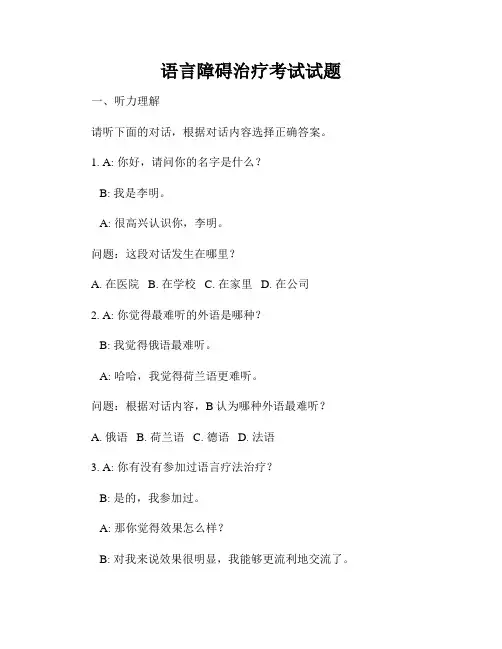
语言障碍治疗考试试题一、听力理解请听下面的对话,根据对话内容选择正确答案。
1. A: 你好,请问你的名字是什么?B: 我是李明。
A: 很高兴认识你,李明。
问题:这段对话发生在哪里?A. 在医院B. 在学校C. 在家里D. 在公司2. A: 你觉得最难听的外语是哪种?B: 我觉得俄语最难听。
A: 哈哈,我觉得荷兰语更难听。
问题:根据对话内容,B认为哪种外语最难听?A. 俄语B. 荷兰语C. 德语D. 法语3. A: 你有没有参加过语言疗法治疗?B: 是的,我参加过。
A: 那你觉得效果怎么样?B: 对我来说效果很明显,我能够更流利地交流了。
问题:B对语言疗法治疗的效果作何评价?A. 效果很明显B. 效果一般C. 效果不明显D. 没有效果二、阅读理解阅读下面的短文,根据短文内容判断句子正误。
正确的选择A,错误的选择B。
语言治疗是帮助那些有语言障碍的人重新建立沟通的一种方法。
语言障碍可能是由脑部损伤、发育延迟、听觉问题等原因引起的。
语言疗法可以通过言语训练、听觉训练、口腔肌肉训练等多种形式来改善病患的语言能力。
1. 语言治疗主要是通过听觉训练来改善语言能力。
2. 语言障碍只有一种原因。
3. 语言治疗可以帮助病患建立新的沟通方式。
三、写作能力根据下面的提示内容,写一篇关于语言障碍治疗的短文。
提示:1. 介绍语言障碍是什么,以及它可能对人们的生活造成的影响。
2. 语言疗法是如何帮助人们克服语言障碍的。
3. 举例说明语言疗法的有效性。
4. 表达个人观点,认为语言疗法在社会中的重要性。
(正文开始)语言障碍是指因脑部损伤、发育延迟、听觉问题等导致的语言能力受损或受阻的情况。
对于患有语言障碍的人们来说,日常的交流和沟通都变得困难起来。
这不仅给他们自身的生活带来了诸多困扰,同时也限制了他们在社会中的交往和发展。
为了帮助这部分人群重新建立起与外界的沟通,语言疗法应运而生。
语言疗法通过不同形式的训练,包括言语训练、听觉训练、口腔肌肉训练等,来改善患者的语言能力。
语言治疗学练习题及答案(总14页)--本页仅作为文档封面,使用时请直接删除即可----内页可以根据需求调整合适字体及大小--语言治疗学练习题一、单选题1.以下为语言治疗的适应征( )A.口吃B.严重的智力障碍C.情感障碍D.行为障碍2.不属于语言训练适应症的是( )A.失语症B.言语发育迟缓C.发声障碍D.行为障碍3.言语流利,但可观察到有理解障碍,但思想和言语表达尚无明显限制,该患者的失语严重程度属于( )级级级级4.以下为语言治疗的禁忌证( )A.构音障碍B.口吃C.失语症D.精神障碍5.听理解相对好的失语症为 ( )A.完全性失语B.运动性失语C.感觉性失语D.经皮质混合性失语6.复述能力差的为 ( )A.经皮质运动性失语B.经皮质感觉性失语C.完全性失语D.命名性失语7.复述能力相对好的失语症为 ( )失语失语 C.经皮质感觉性失语 D.传导性失语8. 决定失语症预后的主要因素是 ( )A.原发疾病和失语类型B.年龄C.智力水平D.性格9. 语言表达过程不包括 ( )A.外部语言B.表达动机C.语义切记D.内部语言10. 听理解差的为 ( )A.命名性失语失语 C.经皮质运动性失语 D.经皮质混合性失语11. 属于流利性失语的是 ( )失语 B.完全性失语 C.命名性失语 D.经皮质混合性失语12. 属于非流利性失语的是 ( )A.命名性失语B.传导性失语C.感觉性失语失语13.笔画的缺漏或添加是属于哪种书写障碍 ( )A.完全性书写障碍B.构字障碍C.镜像文字D.写字过多14. 狭义的构音障碍()A.运动性构音障碍B.器质性构音障碍C.功能性构音障碍D.痉挛性构音障碍15.人类的构音器官不包括()A.鼻B.舌C.心脏D.声带16.构音障碍的临床表现不包括()A.发声困难B.发音不准C.咬字不清D.听理解障碍17.运动性构音障碍的构音评定不包括()A.会话B.单词评定C.音节复述评定D.文章水平评定18.临床上失语症错语中音素之间的置换为()A.词意错语B.语音错语C.新语D.杂乱语 19.哪项检查被认为是吞咽障碍检查的“理想方法”和诊断的“金标准”()A.电视荧光放射吞咽功能检查B.电视内镜吞咽功能检查C.超声检查D.表面肌电图20.言语的概念是()A.一种符号B.人类社会约定俗成的C.只与声带有关D.音声语言形成的机械过程,与神经和肌肉有关21.辅音的发音部位是()A.上,下唇B.舌根后部与硬腭后部C.舌尖与上齿背D.上齿与下唇22.不属于外侧裂周失语综合症的是()失语 B.传导性失语C.命名性失语失语23.属于分水岭区失语综合症的是()A.经皮质感觉性失语B.完全性失语C.命名性失语D.感觉性失语24.爆发性言语多见于哪种构音障碍()A.弛缓性构音障碍B.弛缓型构音障碍C.运动失调性D.混合性失语25.舞蹈病多引起哪种构音障碍()A.弛缓型构音障碍B.运动过多型C.痉挛性构音障碍D.运动失调性26.运动性失调型构音障碍涉及 ( )A.小脑或脑干内传导束病变B.下运动神经元损伤C.上运动神经元损伤D.椎体外系病变27.小脑或脑干内传导来病变所致哪种构音障碍 ( )A.混合性失语B.运动失调型C.痉挛性构音障碍D.运动过少型28.发音训练不包括下列那一项 ( )A.发音器官的启动B.持续发音训练C.鼻音控制训练D.听理解练习29.儿童能够用两词句理解与表达事物状态应达到哪阶段 ( )A.第1阶段阶级 C.第5阶级阶级30. 写出来的字如镜中所见称为 ( )A.象形文字B.写字过多C.镜像书写D.书写惰性现象31.失语症恢复的高峰期是什么时间 ( )A.发病1-2月B.发病2-4月C.发病3-6月D.发病6-12月32. Wernicke失语的临床特征中不包括 ( )A.表达流畅B.听理解相对好C.不能复述D.命名障碍33.分水岭区失语综合征的显著特征是 ( )A.表达流畅B.命名无障碍C.复述好D.听理解正常34.哪项不是口吃的努力性表现 ( )A.解除反应B.助跑表现C.回避D.用脚踢地35.言语频率是指 ( )-20000 Hz -20000 Hz -2000 Hz -3000 Hz36.言语训练的频率中训练效果大的因素不包括 ( )A.次数多B.时间长C.项目多D.间歇长37.现在一般把运动性构音障碍分为()种类型种类型种类型种类型38. 人类获取信息的主要渠道是 ( )A.听觉B.视觉C.触觉D.味觉39. 完整地描述失语症应从哪几个方面着手()A.自发语言、复述、命名、口语理解B.复述、命名、阅读理解、书写C.自发语言、命名、阅读理解、书写D.自发语言、复述、命名、口语理解、阅读理解、书写失语的病灶区域在()A.优势半球额下回后部B.优势半球额中回后部C.优势半球颞上回后部D.优势半球颞中回后部失语的重点训练内容是()A.口语命名、文字称呼B.文字、构音训练C.听理解、会话、复述D.听写、复述42.神经性吞咽障碍咽期障碍最常见症状的是()A.感觉固体食物卡住B.呛咳C.流口水D.咀嚼不当43.错误构音呈固定状态多见于哪种类型的构音障碍 ( )A.功能性B.运动性C.器质性D.痉挛性二、填空题1.言语治疗最初的训练的时间限制在( )内。
语言治疗学练习题一、单选题1.以下为语言治疗的适应征( )A.口吃B.严重的智力障碍C.情感障碍D.行为障碍2.不属于语言训练适应症的是( )A.失语症B.言语发育迟缓C.发声障碍D.行为障碍3.言语流利,但可观察到有理解障碍,但思想和言语表达尚无明显限制,该患者的失语严重程度属于( )A.1级B.2级C.3级D.4级4.以下为语言治疗的禁忌证( )A.构音障碍B.口吃C.失语症D.精神障碍5.听理解相对好的失语症为 ( )A.完全性失语B.运动性失语C.感觉性失语D.经皮质混合性失语6.复述能力差的为 ( )A.经皮质运动性失语B.经皮质感觉性失语C.完全性失语D.命名性失语7.复述能力相对好的失语症为 ( )A.Broca失语B.Wernicke 失语C.经皮质感觉性失语D.传导性失语8. 决定失语症预后的主要因素是 ( )A.原发疾病和失语类型B.年龄C.智力水平D.性格9. 语言表达过程不包括 ( )A.外部语言B.表达动机C.语义切记D.内部语言10. 听理解差的为 ( )A.命名性失语B.Broca失语C.经皮质运动性失语D.经皮质混合性失语11. 属于流利性失语的是 ( )A.Broca失语B.完全性失语C.命名性失语D.经皮质混合性失语12. 属于非流利性失语的是 ( )A.命名性失语B.传导性失语C.感觉性失语D.Broca失语13.笔画的缺漏或添加是属于哪种书写障碍 ( )A.完全性书写障碍B.构字障碍C.镜像文字D.写字过多14.狭义的构音障碍()A.运动性构音障碍B.器质性构音障碍C.功能性构音障碍D.痉挛性构音障碍15.人类的构音器官不包括()A.鼻B.舌C.心脏D.声带16.构音障碍的临床表现不包括()A.发声困难B.发音不准C.咬字不清D.听理解障碍17.运动性构音障碍的构音评定不包括()A.会话B.单词评定C.音节复述评定D.文章水平评定18.临床上失语症错语中音素之间的置换为()A.词意错语B.语音错语C.新语D.杂乱语19.哪项检查被认为是吞咽障碍检查的“理想方法”和诊断的“金标准”()A.电视荧光放射吞咽功能检查B.电视内镜吞咽功能检查C.超声检查D.表面肌电图20.言语的概念是()A.一种符号B.人类社会约定俗成的C.只与声带有关D.音声语言形成的机械过程,与神经和肌肉有关21.辅g.k.h音的发音部位是()A.上,下唇B.舌根后部与硬腭后部C.舌尖与上齿背D.上齿与下唇22.不属于外侧裂周失语综合症的是()A.Broca失语B.传导性失语C.命名性失语D.wernicke失语23.属于分水岭区失语综合症的是()A.经皮质感觉性失语B.完全性失语C.命名性失语D.感觉性失语24.爆发性言语多见于哪种构音障碍()A.弛缓性构音障碍B.弛缓型构音障碍C.运动失调性D.混合性失语25.舞蹈病多引起哪种构音障碍()A.弛缓型构音障碍B.运动过多型C.痉挛性构音障碍D.运动失调性26.运动性失调型构音障碍涉及 ( )A.小脑或脑干内传导束病变B.下运动神经元损伤C.上运动神经元损伤D.椎体外系病变27.小脑或脑干内传导来病变所致哪种构音障碍 ( )A.混合性失语B.运动失调型C.痉挛性构音障碍D.运动过少型28.发音训练不包括下列那一项 ( )A.发音器官的启动B.持续发音训练C.鼻音控制训练D.听理解练习29.儿童能够用两词句理解与表达事物状态应达到哪阶段 ( )A.第1阶段B.3-2阶级C.第5阶级D.4-1阶级30. 写出来的字如镜中所见称为 ( )A.象形文字B.写字过多C.镜像书写D.书写惰性现象31.失语症恢复的高峰期是什么时间 ( )A.发病1-2月B.发病2-4月C.发病3-6月D.发病6-12月32.Wernicke失语的临床特征中不包括 ( )A.表达流畅B.听理解相对好C.不能复述D.命名障碍33.分水岭区失语综合征的显著特征是 ( )A.表达流畅B.命名无障碍C.复述好D.听理解正常34.哪项不是口吃的努力性表现 ( )A.解除反应B.助跑表现C.回避D.用脚踢地35.言语频率是指 ( )A.16-20000HzB.20-20000HzC.300-2000HzD.300-3000Hz36.言语训练的频率中训练效果大的因素不包括 ( )A.次数多B.时间长C.项目多D.间歇长37.现在一般把运动性构音障碍分为()A.4种类型B.5种类型C.6种类型D.8种类型38.人类获取信息的主要渠道是 ( )A.听觉B.视觉C.触觉D.味觉39.完整地描述失语症应从哪几个方面着手()A.自发语言、复述、命名、口语理解B.复述、命名、阅读理解、书写C.自发语言、命名、阅读理解、书写D.自发语言、复述、命名、口语理解、阅读理解、书写40.broca失语的病灶区域在()A.优势半球额下回后部B.优势半球额中回后部C.优势半球颞上回后部D.优势半球颞中回后部41.wernicke失语的重点训练内容是()A.口语命名、文字称呼B.文字、构音训练C.听理解、会话、复述D.听写、复述42.神经性吞咽障碍咽期障碍最常见症状的是()A.感觉固体食物卡住B.呛咳C.流口水D.咀嚼不当43.错误构音呈固定状态多见于哪种类型的构音障碍 ( )A.功能性B.运动性C.器质性D.痉挛性二、填空题1.言语治疗最初的训练的时间限制在( )内。
语言治疗学练习题(附参考答案)一、单选题(共80题,每题1分,共80分)1、功能性构音障碍A、大脑损伤所致的语言丧失或受损B、发音器官和听力等正常的语言障碍C、帕金森病所致的构音障碍D、语言发育落后于实际年龄的语言障碍E、21-三体综合征所致的发音问题正确答案:B2、在清醒、安静和闭眼放松状态下,正常成人脑电图的基本节律是A、8~12Hz的a节律B、8~12Hz的β节律C、4~7Hz的θ节律D、4Hz以下的δ节律E、以上都是正确答案:A3、进食提醒时:照顾者指着自己的嘴唇以提醒患者在吞咽期保持嘴唇闭紧属于A、食物的味道和温度示意B、手势示意C、语言示意D、文字示意E、身体姿势示意正确答案:B4、关于MRI检查安全性论述,错误的是A、正在进行生命监护的危重患者不能进行MRI检查B、早期妊娠妇女接受MRI检查肯定是安全的C、体内有金属异物、人工铁磁性关节等不应行MRI检查D、幽闭症患者不宜做MRI检查E、带有心脏起搏器患者禁止MRI检查正确答案:B5、纠正鼻漏气的训练应选择A、四声音调的辨别和发声训练B、喉部气流的变化训练如吹气球、吹口琴等C、听理解的训练D、引导气流法,如吹的练习E、放松训练、软起声的训练正确答案:D6、某一生活在粤语区的母语为粤语的失语症患者,同时熟练掌握普通话和英语,中风后只能讲简单的粤语。
该患者的语言障碍诊断为A、表达性失语症B、构音障碍C、多语失语症D、汉语失语症E、认知障碍正确答案:C7、大量的评价和治疗方法获得发展的时期是A、1900年以前B、1950--1975年C、1945--1966年D、1930-1950年E、1975-2000年正确答案:C8、该患儿语调单一应该采用何种训练措施A、“推撑”疗法B、韵律训练C、呼吸训练D、发音训练E、克服鼻音化训练正确答案:B9、交流效果促进法具体的代偿手段不包括A、电脑及仪器辅助训练B、图画训练C、书写功能的训练D、手势语的训练E、交流板/交流册的训练正确答案:C10、失语症患者合并以下哪种情况仍可予语言训练A、嗜睡B、严重痴呆C、精神病D、认知障碍E、严重的抑郁症正确答案:D11、Broca区又称A、阅读中枢B、运动性语言中枢C、书写中枢D、感觉性语言中枢E、视觉中枢正确答案:B12、命名性失语的特点A、复述相对保留B、命名障碍C、自发语言流利性D、词量少E、自发语言非流利性正确答案:B13、下列关于说话时呼吸的叙述正确的是A、每次呼气相在5秒以下B、说话时的呼吸是有意识的过程C、每次吸气相在1秒以上D、呼吸肌的运动使吸气压保持在必要的水平E、呼吸肌的运动使呼气压保持在必要的水平正确答案:E14、对 Wernicke失语说法正确的是A、表现为杂乱语B、出现电报式言语C、颞上回的损伤常D、表现听理解障碍轻微E、表现为非流利性口语正确答案:A15、在吞咽前或吞咽时,用来关闭呼吸道入口的吞咽辅助手法是A、门德尔森吞咽手法B、用力吞咽法C、声门下吞咽法D、声门上吞咽法E、超声门上吞咽法正确答案:E16、下面哪种缄默症为器质性缄默症A、选择性缄默症B、癔病性缄默症C、紧张性缄默症D、妄想性缄默症E、无动性缄默症正确答案:E17、语言训练中正确率达到多少时可以升级A、60%~100%B、40%~50%C、50%~60%D、30%~40%E、70%~80%正确答案:E18、呼气相时间为A、0.5秒左右B、5秒以上C、5秒以下D、1秒以上E、2秒以下正确答案:B19、额叶失读症患者最主要的临床特征是A、常伴有严重书写障碍B、表现为字母失读明显,词失读较轻,大多对拼出的字母不认识C、表现为惰性阅读,即阅读思维不能随阅读内容的改变而改变D、表现为近形错读,将刺激字读作形态相似的另一个字E、表现为语句和篇章失读正确答案:B20、假性球麻痹导致的构音障碍类型是A、痉挛型构音障碍B、运动过弱型构音障碍C、失调型构音障碍D、混合型构音障碍E、弛缓型构音障碍正确答案:A21、日本的标准失语症检查是A、BDAEB、WABC、CADLD、SLTAE、Token正确答案:D22、Broca区位于大脑皮层A、颞横回上部B、额中回后部C、弓状纤维D、左侧第三额回下部E、枕叶正确答案:D23、有助于患者心理调节的治疗是A、一对一治疗B、小组治疗C、PACE疗法D、认知刺激疗法E、功能性交际疗法正确答案:B24、下列不是孤独症病因的是A、遗传因素B、孕产期因素C、营养因素D、父母教养E、免疫因素正确答案:D25、洪某,女,43岁。
诚信考试,考试作弊者将不授予学士学位!(详见学校学士学位授予细则文件)《语言治疗学》考试试卷首页(A卷)专业班级学号姓名考试日期:年月日考试时间:100分钟一、名词解释(每题2.5分,共10分)1、构音障碍:2、吞咽障碍:3、语言治疗学:4、语言障碍:二、填空题(每空1分,共15分)1、是人类社会中约定俗成的符号系统。
2、失语症最常见的病因是。
3、正常人吞咽运动包可分为五个阶段:口腔前期、、咽期和食管期。
4、语言障碍常见的类型包括、和。
5、在语言表达中持续重复同样的词或短语,特别是在找不到恰当的表达反应时出现,称为。
6、位于喉腔的最狭窄处,该位置称为声门区,是正常发声的主要部位。
7、将声音转换成特殊编码的电脉冲并刺激内耳的感音结构使个体产生听觉的特殊装置叫。
8、与语言有关的外侧裂周区通常包括、Wernicke区和。
9、患者写一句话或一行字时,字体越写越小,书写慢,笔画可出现不应有的曲折,此种失写现象称为。
10、皮质下失语常见的类型是、。
三、选择题(每题1分,共45分)1、典型的语言障碍是()A.运动性构音障碍B.失语症C.发声障碍D.言语失用2、语言治疗训练形式,原则上应采取()A.小组训练形式B.多对一训练C.二对一训练D.一对一训练3、用来描述人听力水平的名词是()A.分贝B.响度C.频率D.听阈4、鼻音化构音是由于()A.舌肌无力B.咽肌无力C.腭咽机制异常D.悬雍垂过长5、脑瘫儿童进行摄食训练时,那组食物的顺序正确()A.糊状、固体食物、软食、正常食物B.糊状、软食、固体食物、正常食物C.软食、糊状、固体食物、正常食物D.固体食物、糊状、软食、正常食物6、下面哪种检查是属于发声障碍的主观评价()A.内镜检查B.喉空气动力学检查C.喉肌电图检查D.GRBAS评价7、假性球麻痹的损害部位是()A.下运动神经元B.双侧上运动神经元C.声带D.脊髓8、发现环咽肌功能障碍的最佳检查方法是()A.超声检查B.电视内镜吞咽功能检查C.饮水试验D.电视荧光放射吞咽功能检查9、下列对吞咽障碍患者进食要求说法不正确的是()A.鼓励患者小口进食B.在进食下一口食物时要确信患者前一口食物已经吞咽完全C.允许患者有足够的进食时间D.一般进餐后让患者卧位休息20~30分钟10、孤独症起病于()A.幼年时期B.少年时期C.青年时期D.中年时期11、下列不属于孤独症主要临床表现的是()A.语言障碍B.刻板行为C.社交障碍D.肢体瘫痪12、孤独症儿童就诊的最主要原因是()A.注意缺陷B.语言障碍C.多动D.社会交往障碍13、三叉神经支配下述那块肌肉()A.口轮匝肌B.翼内肌C.颊肌D.咽上缩肌14、属于分水岭区失语综合征的是()A.经皮质感觉性失语B.完全性失语C.命名性失语D.感觉性失语15、参与吞咽运动的脑神经不包括()A.三叉神经B.面神经C.舌咽神经D.视神经16、下列关于说话时的呼吸叙述不正确的是()A.说话时的呼吸是在有意识地过程中实现的B.呼吸压要维持一定的时间C.吸气相短于呼气项D.呼吸项在5秒以上17、预防发声障碍,下列哪项是错误的()A.小声说话,保护声带避免过度活动B.注意适当休声C.避免长时间高强度用声D.保持心理稳定,不用声音去发泄18、发声障碍训练,不包括下列哪项()A.体位、呼吸功能的改善B.持续发声训练C.构音器官运动训练D.放松训练19、梁某,女,38岁,外伤后导致视力残疾,现需给患者进行盲文书写训练,最需要以下那个设备()A.盲人地图B.折叠盲杖C.盲文笔和盲文写字板D.盲文读物20、王某,男,46岁,研究生学历,因喉癌行全喉切除术,现需与患者交流,最需要下列那个辅助设备()A.助听器B.闪光门铃C.盲人文具D.语言沟通辅助器21、下列语言治疗的注意事项叙述正确的是()A.力求交流手段单一化B.重视患者本人的训练C.忽略患者的异常反应D.反馈有无均可22、下述哪项功能为右侧大脑半球所有()A.左右定位B.计算力C.绘图、绘画能力D.手指识别23、以下关于分水岭区的叙述哪项不正确()A.大脑中动脉与大脑后动脉分布交界区B.此区受损可引起经皮层性失语C.该区受损,Wernicke区与Broca区的联系中断D.失语特点为复述不受损24、说话时的调音器管包括是()A.双唇B.软腭C.鼻腔D.以上都是25、下列关于声带的叙述正确的是()A.发假声时声带变厚、松弛B.深吸气时声带处于正中位C.发声时声带呈外展位D.发清音时声带持续震动26、张某,女,54岁,颅脑创伤后语言表达虽流畅,但在口语表达中主要表现为找词困难,对说不出的词多以描述物品的功能进行表述。
滁州城市职业技术学院2016语言治疗学考试题班级:_______ 姓名:_______ 学号:_______一名词解释每题2分1.语言治疗技术:2.失语症:3.儿童语言发育迟缓:4.构音障碍:5.听力障碍:6.口吃:7.吞咽障碍:8.痴呆:9.语言:10.言语:二填空题每空1分1.研究表明,儿童在___前,两侧大脑半球都有发展语言功能的潜能;2.言语产生的机理包括大脑控制和调节,发声,调音;其中,发声有______,_______,_____;调音有______,_______,________,________;3.言语的发育分为,辨音期0-7个月,_______8-12个月,_______1-3岁,______4-6岁;4.听力障碍分为,_________________,_______________,____________________ _;5.听力障碍的治疗方法主要有,_________,_________;6.失语症治疗的主要机制有,_____________________,______________________;7.__________________________是多种失语症治疗方法的基础,是自上个世纪多年来应用最广泛的方法之一;8.口吃的诊断包括,____________,______________,__________________________ __;9.吞咽相关的正常解剖结构有,_________,__________,__________;10.正常人的吞咽过程包括,___________,_________,_________,_________,___________; 三简答题共30分1.简述主要失语症的鉴别诊断;5分2.简述真性球麻痹和假性球麻痹导致吞咽障碍的鉴别;5分3.简述吞咽功能评估的方法及各方法如何应用;10分4.简述运动性构音障碍的概念,分类及各类别的主要表现;10分四案例题共20分患者男,57岁,既往有高血压病史,因在打麻将时突然晕倒被送入滁州市第一人民医院,头颅CT显示大脑优势半球Broca区前上部高密度影,经治疗稳定后“因右侧肢体活动不能伴说话障碍一月余”入住我院,查体,神清,精神可,体温℃,呼吸18次/分,血压160/100;心率70次/分;头颅CT复查显示较前高密度区有明显缩小,且亮度有所下降;1.治疗师对患者进行评定发现患者语言症状表现为,非流畅性自发性言语,听觉理解较好,复述良好;该患者失语症类型为;3分2.治疗师运用波士顿诊断性失语症检查将患者失语症严重程度评为2级,请回答BADE失语症严重程度的分级标准;7分3.根据患者BADE失语症严重程度分级确定患者失语治疗长期目标,根据患者失语症的类型确定其训练重点并简述;10分。
言语治疗学试题及答案言语治疗学是一门专注于评估、诊断和治疗沟通障碍以及吞咽障碍的学科。
以下是一份言语治疗学的试题及答案,供参考:一、选择题(每题2分,共20分)1. 言语治疗师主要帮助哪些人群?A. 听力障碍者B. 言语障碍者C. 吞咽障碍者D. 所有以上答案:D2. 下列哪项不是言语治疗的常见方法?A. 语言刺激B. 口腔运动训练C. 药物治疗D. 社交技能训练答案:C3. 儿童言语发展迟缓可能与哪些因素有关?A. 遗传因素B. 环境因素C. 听力障碍D. 所有以上答案:D4. 言语治疗中的“语音”指的是什么?A. 语言的语法结构B. 语言的发音C. 语言的词汇D. 语言的语义答案:B5. 吞咽障碍可能影响以下哪个部位?A. 口腔B. 咽喉C. 食道D. 所有以上答案:D二、填空题(每空2分,共20分)6. 言语治疗的目的之一是提高患者的________能力。
答案:沟通7. 言语障碍包括________、________和语言流畅性障碍等。
答案:发音障碍;语言障碍8. 言语治疗师在评估患者时,会使用一系列________来确定患者的具体障碍。
答案:评估工具9. 吞咽障碍的治疗方法之一是________训练。
答案:口腔运动10. 言语治疗师在治疗过程中,会根据患者的________制定个性化的治疗计划。
答案:具体情况三、简答题(每题10分,共30分)11. 简述言语治疗师在治疗过程中可能使用的一些基本技巧。
答案:言语治疗师在治疗过程中可能使用的基本技巧包括:发音练习、语言刺激、口腔运动训练、呼吸控制、节奏和强度的调整、使用辅助沟通设备等。
12. 描述儿童言语发展迟缓可能面临的问题及言语治疗师如何帮助他们。
答案:儿童言语发展迟缓可能面临的问题包括社交障碍、学习困难、自尊心受损等。
言语治疗师通过评估儿童的言语能力,制定个性化的治疗计划,使用各种言语治疗技巧帮助儿童改善发音、增加词汇量、提高语言理解和表达能力。
语言治疗学试题A
一、单项选择题
1.以下为语言治疗的适应症(A)。
A 口吃
B 严重的智力障碍
C 情感障碍
D 行为障碍
2.以下为语言治疗的禁忌症(D)。
A 构音障碍
B 口吃
C 失语症
D 精神障碍
3.分水岭区失语综合症的显著特征是(C)。
A 表达流畅
B 命名无障碍
C 不能复述
D 命名障碍
4.哪项不是口吃的努力性表现(D)。
A 解除反应
B 助跑表现
C 回避
D 用脚踢地
5.言语训练的频率中训练效果大的因素不包括(C)。
A 次数多 B时间长 C 项目多 D 间歇长
6.听觉障碍(获得语言之后)见于哪一通路受损(A)。
A 听觉传入
B 记号的解释
C 记号记起
D 构音运动
7.口吃见于哪一通路受损(D)。
A 听觉传入
B 记号的解释
C 记号记起
D 构音运动
8.Broca失语的临床特征中不包括( C)。
A 表达不流畅
B 听理解相对好
C 复述正常
D 命名障碍
9.分水岭区失语综合征的显著特征是(C )。
A 表达流畅
B 命名无障碍
C 复述好
D 听理解正常
10.错误构音呈固定状态多见于(B )构音障碍。
A 运动性
B 功能性
C 器质性
D 痉挛性
11.聋儿训练的原则中没有哪项(D )。
A 尽早查明听力
B 尽早配助听器
C 尽早进行科学的听力言语训练
D 尽早手术
12.悄悄行驶的小汽车发出( C)分贝的声音。
A 2 0-30
B 30-40
C 40-50
D 50-60
13.不属于语言训练适应症的是(D)
A、失语症
B、语言发育迟缓
C、发声障碍
D、行为障碍
E、构音障碍
14.在“言语链”中,属于言语学水平的是(A)
A、大脑语言中枢
B、构音器官
C、耳朵
D、声音的大小
15.决定失语症预后的主要因素是(A)
A、原发疾病和失语类型
B、年龄
C、智力水平
D、性格
E、性别
16.影响言语交流的心理因素不包括(A)
A、交流者的智商
B、交流循环系统
C、交流角色关系
D、交流环境
E、交流者的欲望
17.汉语标准失语症检查采取级评分标准(D)
A 3
B 4
C 5
D 6
18.现在一般把运动性构音障碍分为(C)
A 4种类型
B 5种类型
C 6种类型
D 8种类型
E 2种类型
19.影响言语交流的认知因素不包括(D)。
A 接受能力
B 记忆和学习能力
C 思维能力
D 空间知觉能力
E 意识与注意能力
20.以下为语言治疗的禁忌症(B)
A 构音障碍
B 口吃
C 失语症
D 精神障碍
二、填空题
1.言语治疗最初的训练的时间限制在内。
(30min)。